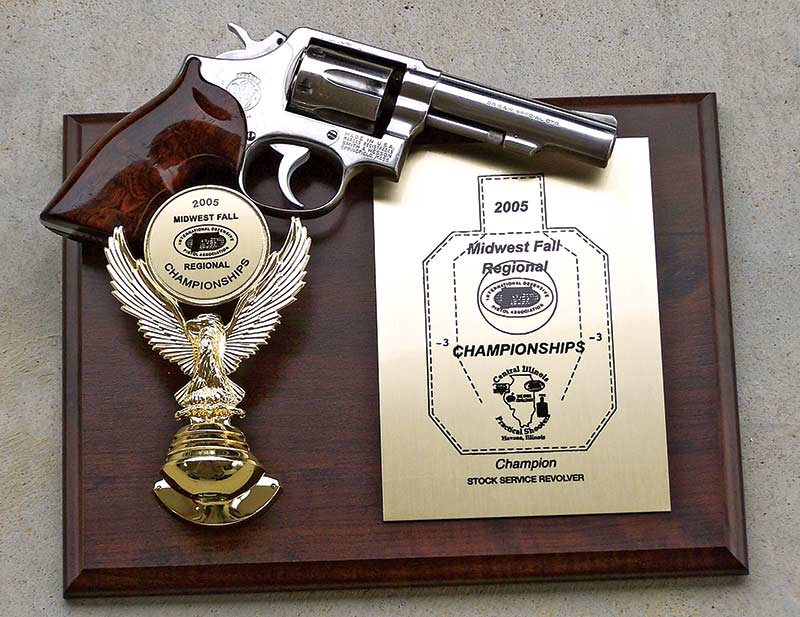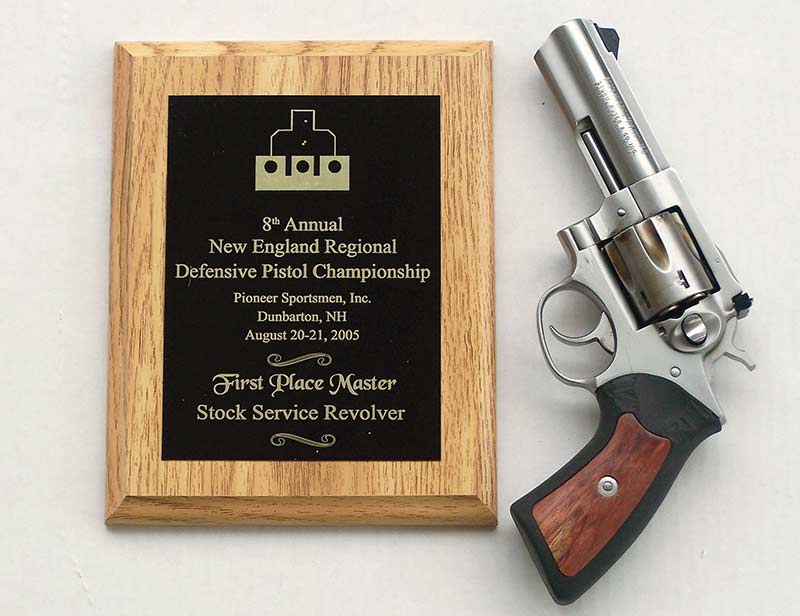STOCK SERVICE REVOLVER
The easiest and cheapest way to start IDPA competition
When the International Defensive Pistol Association (IDPA) was formed a decade ago, the founders knew the service revolver was all but extinct in law enforcement, though it was still widely seen in security. However, they also knew a great many armed citizens still trusted police style six-shooters as home-defense guns and even as carry guns, and they didn’t want to exclude them.
The original Stock Service Revolver category (SSR) encompassed revolvers of .38 Special caliber and larger, with up to 5″ barrels. The length limit, before too terribly long, was cut to 4″. This perturbed a number of shooters who had purchased S&W Model 625 .45 ACP revolvers with 5″ barrels, and Smith & Wesson — one of IDPA’s strongest sponsors throughout the history of the fledgling sport — offered to convert 5″ 625s to 4″ for a mere $100, which was a good deal.
As noted in a previous column, the moon-clip revolvers taking auto pistol cartridges, notably the 625, had so much of an advantage over guns fed with conventional speedloaders, IDPA split the “moon guns” into their own Enhanced Service Revolver (ESR) category, limiting SSR to rimmed revolver cartridges in second quarter 2005. This changed the face of the IDPA revolver game.
SSR Today
Most of the IDPA match sponsors I talk to around the country tell me the new rules have invigorated revolver shooting in their game. I see the occasional venue where the local six-gunners have all invested in “moon guns,” and ESR entries outnumber SSR entries by three times or more. However, it’s more common to see clubs where SSR entries have skyrocketed, with ESR entries down a little bit. Once you’ve got an IDPA revolver you like, you stick with it. An example is my buddy Steve Denney, who bought a couple of 625s and stayed with ’em after the rule change. He continues to win his class, in ESR now instead of in SSR, and he’s happy with the concept. No argument here.
However, there are a heckuva lot more folks who own a service-type revolver in .38 or .357 with 4″ or shorter barrel, and they like the idea of being able to take it to a match now and then. This is one reason, I think, why the rule change has increased revolver entries overall at the IDPA matches I’ve attended around the country in the past year.
For the new shooter just getting into competition, the still-glutted market of trade-in police service revolvers makes SSR the cheapest category in which to get started. In 2005, just to make a point, I bought one of many S&W Model 64 (Kframe, 4″ heavy barrel stainless .38 Special) trade-ins on sale for $179.95 at Ocala Armory in Ocala, Florida. It came with Safariland fingergroove grips, which I left in place. I didn’t do anything to it. I took some $1-apiece HKS speedloaders, also police trades, from the “used stuff” bin at another gun shop, and put them together with $5-apiece used holster and loader pouch.
With this gear, I won SSR at a local IDPA match. Encouraged, I splurged on a Blade-Tech Kydex speed holster and some Safariland Comp-III Speedloaders, and won the 2005 Midwest Regional IDPA Championship, SSR Category, at Havana, Illinois. My equipment still represented the lowest investment, by far, of any of the five category champions there. Proof that SSR is the cheapest entry portal to IDPA competition.
Winning Guns & Loads
If I was just starting out, with a full checkbook, my SSR would likely be an L-frame S&W 686 with an action job and a good, fast holster. I won the New Hampshire State Championship one year with a 686 tuned by Bob Lloyd, and a Mitch Rosen Ayoob Rear Guard holster. That gun is still tough to beat. I took a local match last year with a Thunder Ranch Model 21, using .44 Special ammo in Model 29 HKS speedloaders. However, S&W’s K-frames can really kick butt. I saw Dan Klimosky win the Mid-Winter Nationals one year with a Model 19, and Brent Purucker win it more than once with a fixed sight Model 13, both K-frames firing .38 Special ammo. And one year, Dave Elderton took the Wisconsin State Championship with a Model 66, firing full power .357 Magnum loads … and all three performed those feats back when they were shooting against moon-clip revolvers!
S&W may rule IDPA SSR, but it sure doesn’t own it. Former Midwest champion Dave Maglio earned the coveted Four-Gun Master ranking with a
Ruger GP100 traded in years before by the Milwaukee PD. I won the New England Regional in SSR in the summer of ’05 with an out-of-the-box GP100. I watched Jon Strayer win a local match with Ruger’s Alaskan snubby in .454 Casull, which just makes the IDPA weight limit thanks to its short barrel, using .45 Colt ammo in HKS 25-5 speedloaders.
Mike Benedict made Master in the moon clip days using a Colt Python .357 Magnum. On the other end of the price spectrum, I’ve seen Taurus
revolvers turn in good SSR scores.
SSR demands a 125,000 power factor (bullet weight x velocity). This means a +P loading in .38 Special, probably using a 158-grain bullet. It also means a bigbore revolver could loaf along with a light “cowboy action” load, say a 230-grain roundnose lead at 600 fps, which would
make the limit with power to spare. Such .44 and .45 rounds actually kick less in a heavy N-frame revolver than .38 +P in a K-frame, at least in my hands. If I’m going to use factory ammo in a .38/.357, it’ll be CCI Speer Lawman 158 grain +P FMJ. With handloading, though, you can come down a little from that stout load and still make the power floor. I’d recommend roundnose bullets, for faster speedloading . Safariland’s Comp-III is the fastest speedloader I’ve found, though it’s available only in Kframe and L-frame S&W size. Their Comp-II is the second fastest, and available for more guns. The HKS is a tad slower than either, but available for more models, and is probably the most reliable duty speedloader around.
You pays your money and you takes your choice. SSR is the easiest to get into of the IDPA gun categories cost-wise, but with reloads necessary after every six shots, you won’t be likely to win specialty categories like High Lawman, High Lady, or High Senior if you don’t have an 11-shot auto like those allowed in Stock Service Pistol and Enhanced Service Pistol. In almost a decade of IDPA competition, I’ve won just one of those with a sixgun, High Senior at the Mid-Winter Nationals of 1999 with a Model 625 tuned by Al Greco and loaded with full-moon clips.
Thus ends our several-part series on “the state of IDPA.” It’s my favorite form of competition, because it’s geared to people like me who carry a concealed handgun every day. If it sounds like your cup of tea, you can get all the info you need by surfing the net to
www.idpa.com.





